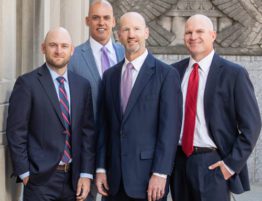A rear end collision is when one vehicle crashes into the back of another vehicle.
In most cases, the driver who was in the back is at fault for causing the crash. Even if the lead vehicle stops quickly, the rear driver should be following at a reasonable distance so they can stop without causing a crash.
However, there are some exceptions to this rule.
In this short guide, we’ll break down how Missouri determines fault in car crashes, who is typically at fault in rear-end collisions and those exceptions where the rear driver might not be liable for the crash.
How Missouri determines fault in car accidents
Missouri is an “at-fault” state. This means that if you’re involved in a car accident, the driver determined to have caused the crash pays for both parties’ damages. The at-fault driver’s insurance company will pay for the other party’s medical bills and property damage.
If both drivers played a role in the collision, Missouri law allows for both drivers to be assigned a percentage of fault between 1 and 99%. For example, if one driver was determined to be 40% responsible for the crash, they would pay 40% of the damages and the other driver would cover 60%.
Who is at fault in a rear end collision?
The rear driver is usually at fault in most rear-end collisions in Missouri. According to the state’s “Rear-End Doctrine,” the driver who rear-ends another car is automatically assumed to be at fault for the crash, except in cases where the lead driver is negligent or behaves in such a way that the rear driver can’t reasonably expect to avoid a car accident.
Missouri law defines the concept of negligence as the failure to exercise a reasonable level of care when operating a motor vehicle. Negligence can include behaviors such as excessive speeding, using your cell phone or driving under the influence.
In other words, if you were driving the car that rear ended someone else, you will likely be the at-fault driver unless there is evidence that shows the other driver did something to cause the crash.
If someone brake checks you, who is at fault?
Brake checking describes a situation where the lead car abruptly slams on their brakes in order to cause the rear driver to react. This often arises in cases of road rage.
Brake checking is dangerous. It not only puts the lead vehicle in danger but all other cars on the roadway as well. As a result, brake checking can be considered negligent driving, and it can put the lead driver at fault for at least a percentage of any resulting damages.
Other exceptions to Missouri’s ‘Rear-End Doctrine’
In some cases, a driver who crashed into the back of another car might not be assigned fault. For example, in a three car pileup, if the middle driver was following the lead driver at a safe distance and was pushed into the lead driver by the car behind them, they might not be found at fault for the collision.
As always with any legal matter, the details and evidence in your case can determine how the situation unfolds. It’s important to speak with an experienced attorney if you’re involved in an accident and are unsure who is at fault.
An experienced car accident attorney can help you determine who is liable for any property damage or medical bills associated with the collision.
Need legal help?
If you’re involved in a rear-end crash and are unsure who is at fault, don’t hesitate to speak with an experienced car accident lawyer.
At Niemeyer, Grebel and Kruse, our attorneys have years of experience helping people who have been injured in car accidents. Contact us for a free consultation today to discuss your case – 314-241-1919.

